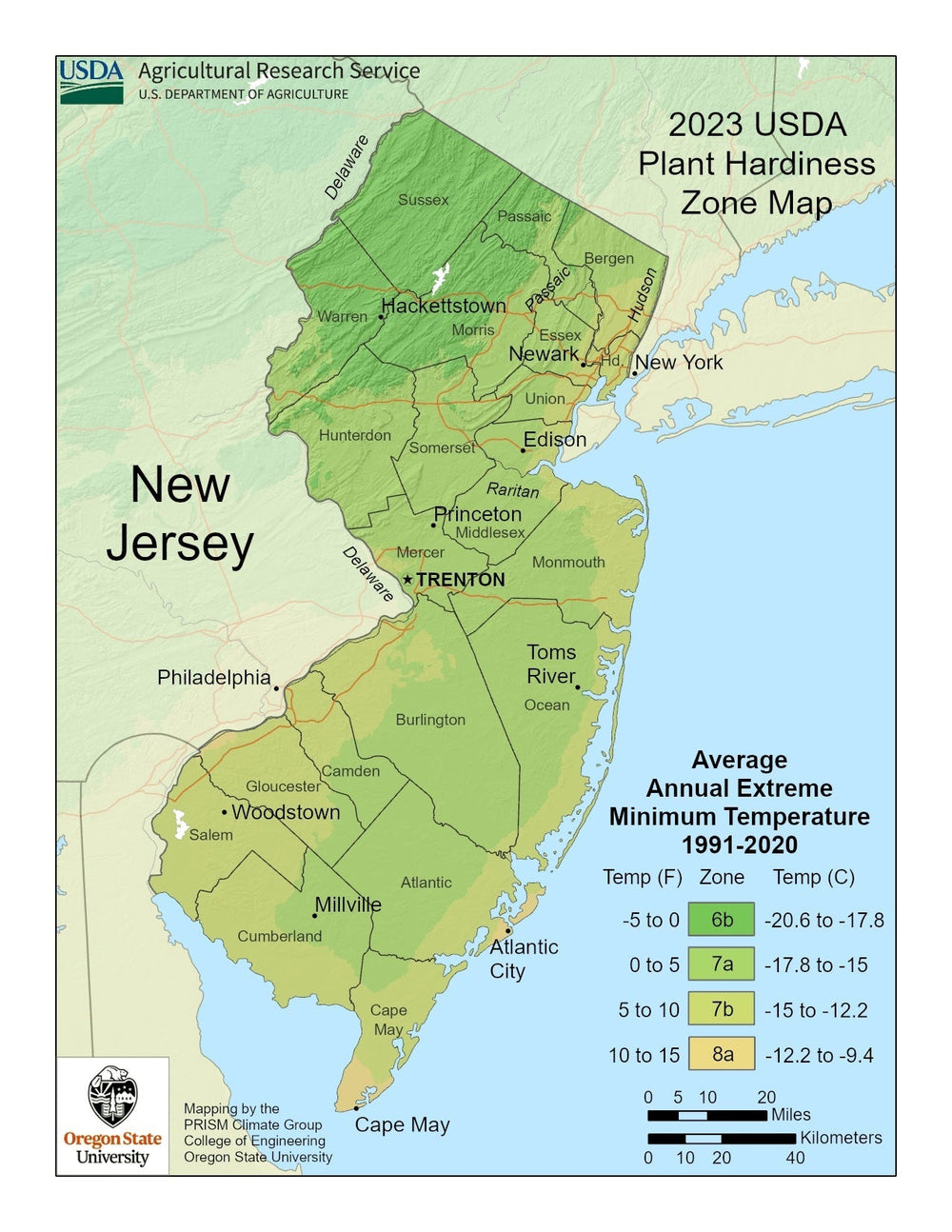Image from USDA
Characteristics of New Jersey’s Planting Region
New Jersey's climate is classified as humid subtropical in the south and humid continental in the north, influenced significantly by both the Atlantic Ocean and elevation changes. The state's geography creates notable variations in growing conditions between the coastal and inland regions.
As a New Jersey gardener, you can expect:
- moderate summers with July temperatures averaging 72°F to 82°F (22.2°C to 27.8°C)
- variable winters with January averages ranging from 24°F to 35°F (-4.4°C to 1.7°C).
- Annual rainfall averages 43-51 inches, distributed fairly evenly throughout the year, while coastal regions benefit from maritime influence that moderates temperature extremes.
The New Jersey growing season varies by region:
- Northern Highlands: Mid-May to early October
- Central Region: Late April to mid-October
- Coastal Areas: Mid-April to late October
- Pine Barrens: Late April to mid-October

Challenges of Growing in New Jersey
Coastal Salt Exposure
Gardens near the shoreface salt spray and sandy soils that drain rapidly, creating unique moisture management challenges. The maritime environment affects plant selection and requires careful consideration of windbreaks and soil amendments.
Variable Soil Conditions
The state's geological diversity creates distinct soil types, from the acidic sandy soils of the Pine Barrens to the clay-heavy soils of the north. Urban areas often contend with compacted, disturbed soils requiring significant amendment.
Humid Climate Pressure
High humidity levels, particularly during summer, create perfect conditions for fungal diseases and pest proliferation. The combination of moisture and heat requires vigilant plant monitoring and proper air circulation management.

The Benefits of Using a Greenhouse in New Jersey
For New Jersey gardeners, a greenhouse is an essential investment that converts weather-vulnerable garden spaces into protected year-round growing environments.
Here's how a sheltered growing space can transform your New Jersey garden and shield it from coastal storms, unpredictable spring weather, and humid summer conditions:
1. Extend Your Growing Season
-
Without a Greenhouse: The outdoor growing season in central New Jersey typically runs from late April through early October, with coastal areas enjoying slightly longer seasons. Unpredictable spring frosts and autumn storms can disrupt planting schedules.
-
With a Greenhouse: Growing seasons can begin in February and extend through December, with proper climate control allowing for year-round cultivation of certain crops. Protection from nor'easters and late-season hurricanes ensures crop survival during extreme weather events.
Learn more about your area's specific growing dates and the best vegetables to plant in each part of New Jersey.
 Customer images of their Greenhouse setup in New Jersey
Customer images of their Greenhouse setup in New Jersey
2. Grow a Wider Variety of Vegetables Without a Greenhouse:
-
Without a Greenhouse:
New Jersey outdoor gardens typically succeed with:
|
|
-
With a Greenhouse:
A controlled environment enables growing a lot more:
|
|
|
Why Planta Greenhouses?
- Wind resistant up to 65 mph (learn more about how our greenhouses hold up in high-altitude climates).
- Withstands a snow load of up to 98 psf (480kg/square meter).
- Made with a heavy-duty galvanized steel frame.
- Polycarbonate panels provide 100% protection against UV rays.
- The Sungrow greenhouse is bell-shaped - allows the wind, snow, and hail to slide off the sides.
- Extendable (Sungrow, Sigma and Farmer models can be extended beyond 100ft)
- Made in Europe and are exclusively imported
- Maintenance-free

